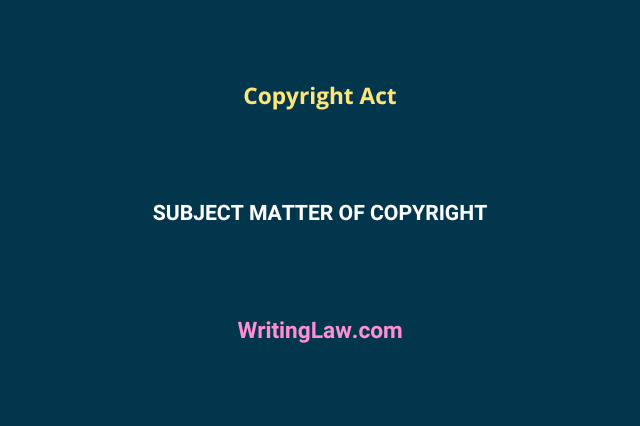
Copyright law protects and fosters creativity, innovation, and cultural expression. One of the fundamental aspects of copyright law is the concept of subject matter, which refers to the types of works that are eligible for copyright protection.
The subject matter of copyright encompasses a wide range of creative and intellectual creations, spanning various artistic, literary, musical, dramatic, artistic, sound recording, architecture and cinematography films.
The categories of works for which copyright is applicable in India are listed in section 13 of the Indian Copyright Act, 1957. These seven types of works are covered by copyright protection under this section.
Literary Work
Section 2(o) of the Indian Copyright Act defines the term literary work.
The Act states that literary works include computer programs, collections of tables, and computer databases. However, it is not clear what will be considered to be a literary work.
This (the above statement that provides what constitutes a literary work under copyright law) makes it clear that literary work, other than dramatic and musical work, includes words conveyed in print and writing in addition to literary works.
The copyright also covers numerals and symbols. Additionally, any written expression, computer program, or data compilation, regardless of its artistic merit, will be considered a literary work and will enjoy copyright protection.
Dramatic Work
Section 2(h) of the Indian Copyright Act defines dramatic works.
Compositions that include recitations, choreography, or entertainment done without words and the structure of the performance is predetermined in writing or another form are referred to as dramatic works. Cinematographic films are excluded under this criterion, though.
Any performance that may be performed in front of an audience, with or without words or music, is a dramatic work. The copyright and the text also cover the work’s dramatic components.
A dramatic work’s plot or narrative forms its core. To qualify for copyright protection, the performer’s actions must be described in writing. Therefore, a dance or pantomime cannot be protected as a theatrical work without a textual description.
Musical Work
Section 2(p) of the Indian Copyright Act defines musical work.
A musical work is a composition that includes both music and visual notation. It excludes any actions or words intended to be performed, sung, or spoken with the music. The words are the literary portion of a song, and the music, which is the musical portion, are its two separate parts. The song as a whole is made up of these two components. The person who creates the lyrics is regarded as the author of that work since the lyrics constitute the literary component, which is protected as a type of literary work.
On the other hand, the song’s accompaniment is recognised as a separate musical work, and the composer is acknowledged as its author. As a result, there may be two sets of rights inside a song: one for the literary work (lyrics) and another for the musical work, each owned by a distinct person who is the respective author of each component.
Artistic Work
Section 2(c) of the Indian Copyright Act defines artistic works.
It comprises paintings, drawings with maps, charts, plans, diagrams, photographs, and engravings without needing them to be works of art. It also covers any other handcrafted items and works of architecture. There is no requirement for any artistic merit. Hence, there is no subjective evaluation of the artwork’s quality for it to be protected under copyright. Instead, the work must be unique. Any original work of art is, therefore, subject to copyright protection.
Cinematograph Films
Section 2(f) of the Indian Copyright Act defines cinematograph films.
It declares that visual recordings are covered by copyright, including the visual element and any ancillary sound recording. Any piece of art produced using methods related to cinematography, including video films, is considered a “cinematograph” under the term’s broad definition. For cinematograph films, the producer is given the authorship for the work.
Sound Recording
Section 2(xx) of the Indian Copyright Act defines sound recording.
Regardless of the process and mode used to create or make the recording, sound recording may be described as recording noises from which the sound is formed. However, the copyright of other works should not be violated by the sound recording that is being generated.
Example: CD-ROM
Architecture Work
Section 2(b) of the Indian Copyright Act defines architecture work.
The copyright in architectural works is covered in section 13(5) of the Indian Copyright Act. The following are domains of architecture work where copyright is present and is protected as artistic works:
- Characteristics of architecture
- Architecture design
The techniques and process of building are not protected by copyright in architecture.
Conclusion
To sum up, the subject matter of copyright is diverse and encompasses a wide range of creative and intellectual creations. Copyright protection extends to various categories of works as defined in the Indian Copyright Act.
Literary works, including computer programs and databases, are eligible for copyright protection, regardless of their quality or style. Dramatic works cover performances such as recitations and choreographic works, while musical works consist of music and graphical notation separate from the accompanying lyrics. Artistic works, including paintings, drawings, and photographs, are protected irrespective of artistic quality.
Cinematograph films, which include visual recordings and accompanying sound, are also subject to copyright, with authorship attributed to the producer. Sound recordings involve the recording of sounds and should not infringe upon the copyrights of other works. Architecture works, including architectural character and design, are protected under artistic works but not the methods or processes of construction.
Overall, copyright law recognises and safeguards individuals’ creative efforts and expressions across a broad spectrum of artistic, literary, musical, audiovisual, and architectural domains, fostering a climate of innovation and protection for creators in India.
- What Is Misappropriation of Trade Secrets and Its Defences? - 15th May 2024
- 7 Important Types of Mediation Briefly Defined - 14th May 2024
- Whirlpool India vs Videocon Industries – Case Explained - 13th May 2024







